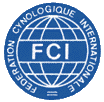
Secrétariat Général: 13, Place Albert 1 – B 6530 Thuin (Belgium)

|
FÉDÉRATION CYNOLOGIQUE INTERNATIONALE
Secrétariat Général: 13, Place Albert 1 – B 6530 Thuin (Belgium) |
Date of Publication of The Original Valid Standard: 15.06.1992
Shiba Inu  |
FCI Standard N° 257 |
Origin:
Japan.
Utilization:
Hunting dog for birds and small animals. Companion dog.
FCI Classification:
Group 5 – Spitz and primitive types.
Section 5 – Asian Spitz and related breeds.
Without working trial.
Brief Historical Summary:
The Shiba has been a native breed to Japan since the primitive ages. The word "Shiba" originally refers to something "small", a "small dog". The Shiba's habitat was in the mountainous area facing the Sea of Japan and was used as a hunting dog for small animals and birds. There were slight differences in the breeds according to the areas where they were raised.
As dogs like English Setters and English Pointers were imported from England during the period of 1868-1912, hunting became a sport in Japan and cross breeding of the Shiba with those English dogs became prevalent and a pure Shiba became rare so that by 1912-1926 pure Shibas confined to these areas became exceedingly scarce. Hunters and other educated persons became concerned with the preservation of the pure Shibas from around 1928 and the preservation of the limited number of pure strains began seriously, and the breed standard was finally unified in 1934. In 1937 the Shiba was designated as a natural monument after which the breed was bred and improved to become the superior breed known today.
General Appearance:
Small-sized dog, well balanced, well boned with well developed muscles. Constitution strong. Action quick, free and beautiful.
Important Proportions:
The ratio of height at withers to length of body is 10:11.
Behaviour/Temperament:
The temperament is faithful, with keenness in sense and high alertness.
Head:
Forehead: Broad.
Cheeks: Well developed.
Stop: Defined with slight furrow.
Nasal bridge: Straight and nose black in color desirable.
Muzzle: Moderately thick and tapering.
Lips: Tight, and teeth strong with scissor bite.
Eyes: Relatively small, triangular and dark brown in color; the corners of the eyes are upturned.
Ears: Relatively small, triangular, slightly inclining forward and firmly pricked.
Neck:
Thick, strong, and well balanced with the head and the body.
Body:
Back: Straight and strong.
Loin: Broad and muscular.
Chest: Deep, ribs moderately sprung.
Belly: Well drawn up.
Tail:
Set on high, thick, carried vigorously curled or curved as a sickle, the tip nearly reaching hocks when let down.
Forequarters:
Shoulders: Moderately sloping.
Elbows: Tight; seen from the front, forelegs straight.
Hindquarters:
Upper thighs: Long.
Lower thighs: Short, but well developed.
Hocks: Thick and tough.
Feet:
Digits tightly closed and well arched. Pads hard and elastic. Nails hard and dark in color desirable.
Gait:
Light and brisk.
Coat:
Hair: Outer coat harsh and straight, undercoat soft and dense; hair on tail slightly long and standing off.
Colour:
Red, black and tan, sesame, black sesame, red sesame.
Definition of the colour sesame:
All the above mentioned colors must have "Urajiro". "Urajiro" = whitish coat on the sides of the muzzle and on the cheeks, on the underside of the jaw and neck, on the chest and stomach and the underside of the tail, and on the inside of the legs.
Size:
Height at withers:
Dogs 40 cm.
Bitches 37 cm.
There is a tolerance of 1.5 cm smaller or taller.
Faults:
Any departure from the foregoing points should be considered as a fault and the seriousness with which the fault should be regarded should be in exact proportion to its degree.
Disqualifying Faults:
Note:
Male animals should have two apparently normal testicles fully descended into the scrotum.